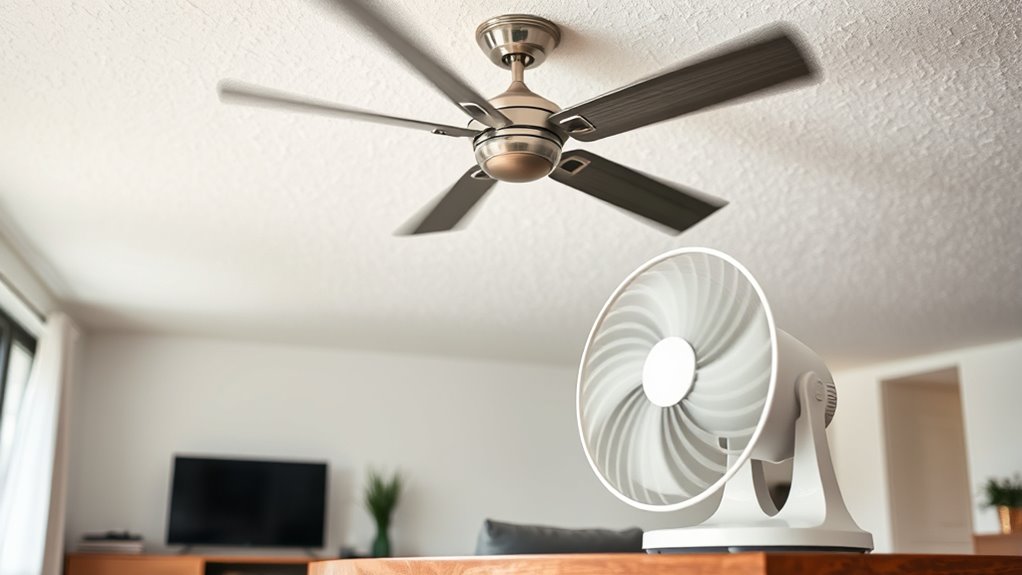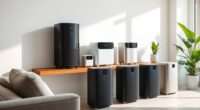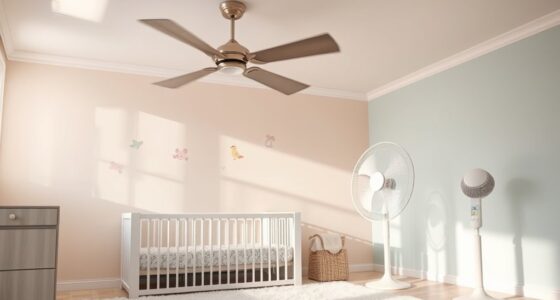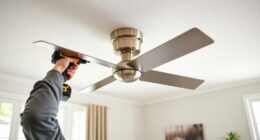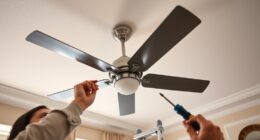When comparing cooling efficiency, ceiling fans are best for larger spaces, providing steady airflow that circulates air evenly and conserves energy. Portable fans deliver targeted, quick cooling ideal for small areas or personal use but may use more power over time. Your choice depends on room size, installation preferences, and aesthetics. If you want to know how each performs in specific situations, explore further to find the right fit for your space.
Key Takeaways
- Ceiling fans provide broader, consistent airflow suitable for large rooms, enhancing overall cooling efficiency.
- Portable fans deliver targeted, direct airflow ideal for small spaces or personal cooling.
- Ceiling fans operate with lower energy consumption, making them more cost-effective for sustained use.
- Portable fans are easier to position for quick, localized cooling but may consume more power over time.
- Overall, ceiling fans excel in energy efficiency and room coverage, while portable fans offer flexible, spot cooling.
Comparing Cooling Power and Air Circulation
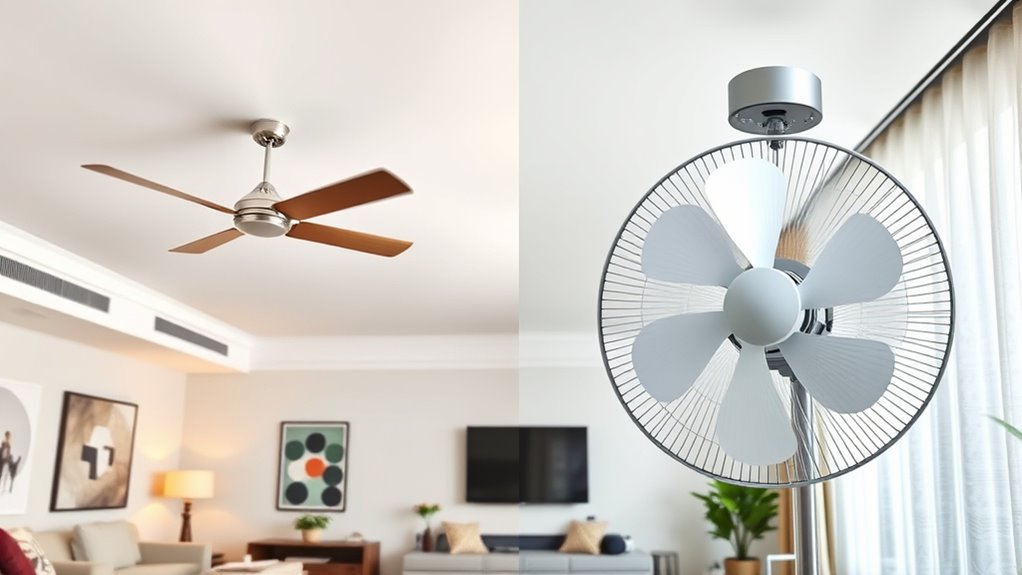
When it comes to cooling power and air circulation, ceiling fans and portable fans serve different needs. Ceiling fans create broad airflow patterns that evenly distribute air across a room, making them effective for continuous circulation. They tend to have quieter noise levels, allowing for comfort during long periods of use. Portable fans, on the other hand, produce more direct airflow, which can be ideal for targeted cooling. However, their noise levels are often higher, especially at maximum settings, which might be distracting. If you want steady, whole-room airflow with minimal noise, a ceiling fan is usually better. But if you need to direct air to a specific area quickly, a portable fan can deliver more immediate cooling, even if it’s noisier.
Energy Consumption and Cost Efficiency
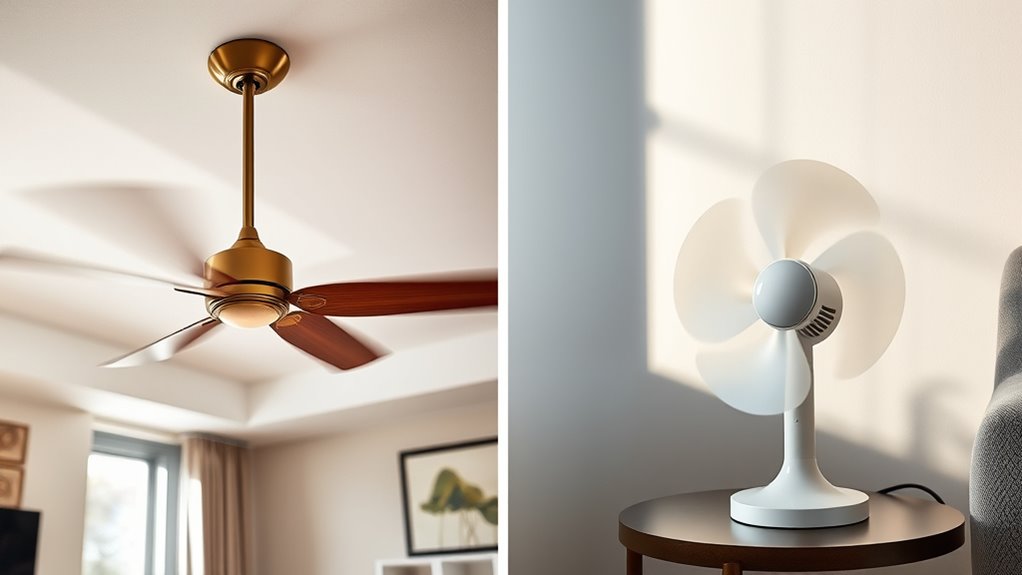
Ceiling fans generally consume less energy than portable fans, making them more cost-effective for long-term use. Their lower power draw results in significant energy savings over time, reducing your electricity bills. When performing a cost analysis, you’ll find that ceiling fans often have a higher upfront cost but lower running expenses. Portable fans, while cheaper initially, tend to use more power, leading to higher energy costs during extended use. To maximize efficiency, consider factors like fan size and speed settings. Additionally, choosing energy-efficient models can further optimize your cooling costs and reduce environmental impact. Incorporating smart technology into your fan choices can also help monitor and control energy consumption more effectively. Moreover, selecting fans with advanced motor technology can enhance performance while maintaining energy savings.
Suitability for Different Room Sizes
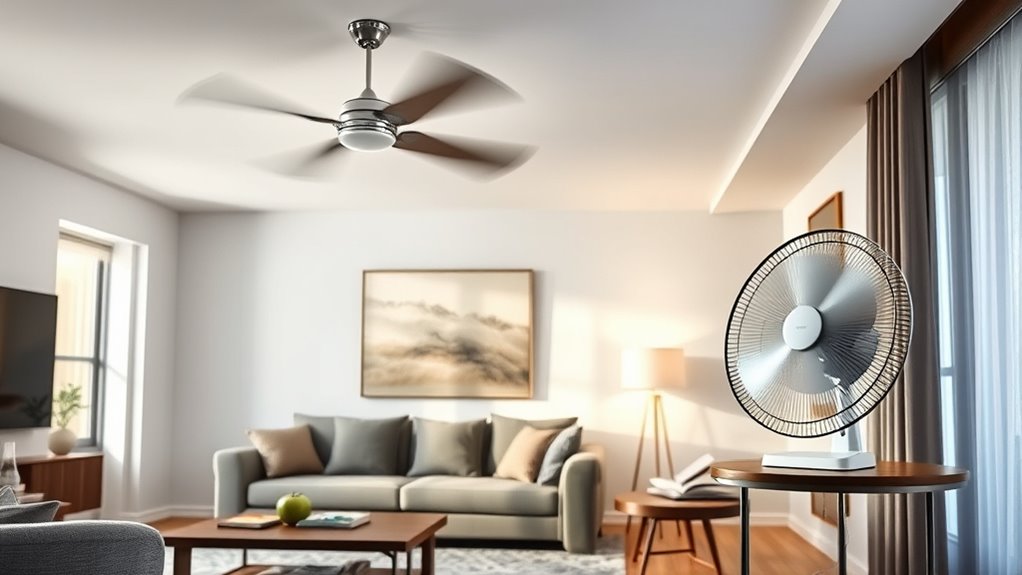
Choosing the right fan depends heavily on the size of the room you want to cool. For smaller spaces, a portable fan offers quick, targeted airflow and is easy to move around. Its room suitability is limited to areas up to about 150 square feet, so it works well for personal use or small rooms. Larger rooms, however, benefit more from a ceiling fan, which can circulate air efficiently across a broader area. Proper fan placement is essential: ceiling fans should be centered in the room for even distribution, while portable fans should be positioned to optimize airflow without obstruction. Understanding your room’s size helps you select the most suitable fan, ensuring effective cooling and comfortable airflow where you need it most. Additionally, considering vetted small wood stoves can be a cozy alternative for heating larger spaces when cooling is not the primary concern.
Installation and Mobility Considerations
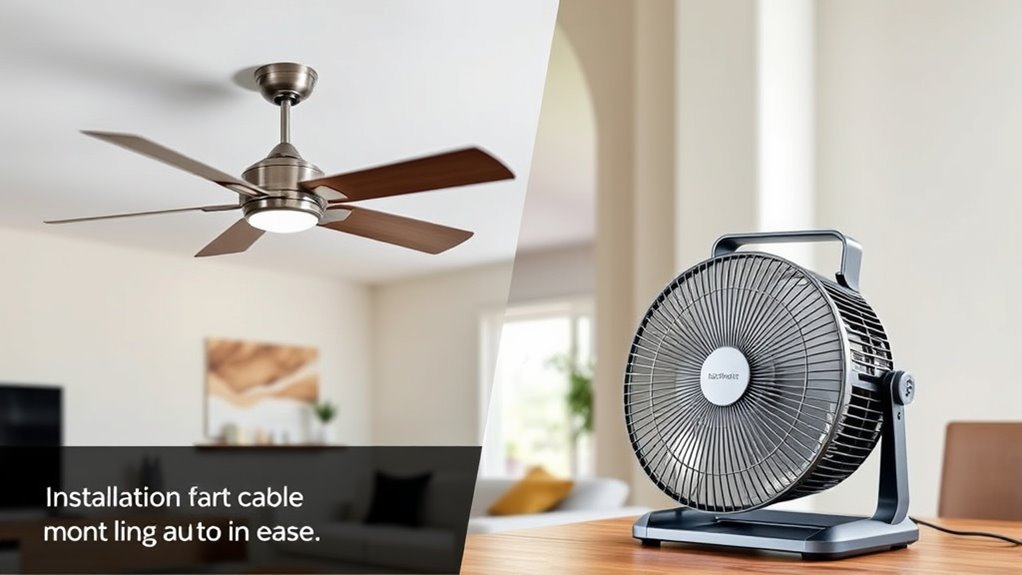
When choosing between a ceiling fan and a portable fan, you should consider how easy they are to install and move around. Ceiling fans often require more complex installation, while portable fans can be set up quickly and relocated easily. Think about where you’ll want your fan and how often you’ll need to change its placement. Additionally, consider the ease of maintenance for each type, as some portable fans may be easier to clean and service regularly. Moreover, the installation complexity of ceiling fans can vary depending on your ceiling type and existing wiring, which may influence your decision. It’s also helpful to assess the community engagement aspects, such as user reviews and recommendations, which can provide insight into the long-term usability of each fan type.
Installation Ease and Complexity
Installing a ceiling fan typically requires more effort and planning compared to setting up a portable fan. You’ll need to locate a ceiling mount spot, ensure proper wiring, and possibly hire an electrician. Once installed, many models come with a wireless remote for easy control, but initial setup might be complex. Portable fans, on the other hand, are straightforward—just plug them in and position. Additionally, choosing the right design style can enhance your room’s aesthetic while ensuring effective cooling. Wireless remotes add convenience but require proper pairing with ceiling fans. It’s also important to consider privacy and cookie policies, especially if the fan includes smart features that connect to your home network.
Portability and Placement Flexibility
While ceiling fans are permanently mounted and require careful planning during installation, portable fans offer unmatched flexibility in placement. You can move them easily from room to room, adjusting for ideal airflow where needed. This mobility allows you to target specific areas and adapt to changing needs quickly. Noise levels vary among models; some portable fans operate quietly, while others can be noisy, impacting comfort. Additionally, portable fans tend to have lower upfront costs and fewer installation expenses, making them a budget-friendly option. However, keep in mind that frequent movement or placement on uneven surfaces may affect stability and noise. Overall, portable fans provide convenience and adaptability, making them ideal if you value flexibility and quick setup. Understanding fan efficiency can help you choose models that maximize cooling with minimal noise and energy use. Optimizing airflow distribution ensures more effective cooling and energy savings over time. Additionally, selecting models with energy-efficient motors can further enhance performance and reduce operating costs.
Aesthetic Appeal and Design Options
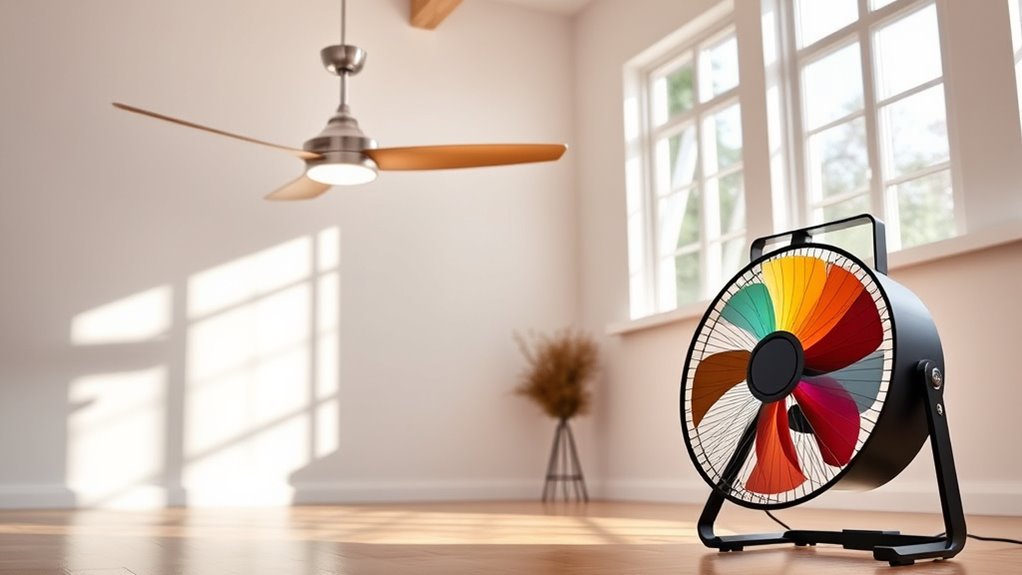
Your choice of fan can considerably enhance your space’s look, with a wide range of styles and trending designs available. Ceiling fans often feature sleek, modern lines or classic finishes, while portable fans come in various shapes and colors to match any decor. Plus, many models offer customizable aesthetic options, so you can tailor the appearance to fit your personal style. Incorporating vintage-inspired designs can also add rustic charm and complement farmhouse or traditional decor themes. Additionally, selecting fans with aesthetic versatility allows for seamless integration into diverse interior styles, enhancing both functionality and visual appeal. Considering the design options can help you find a fan that not only cools effectively but also elevates your space’s overall decor.
Style Variety and Trends
When it comes to style variety and trends, ceiling fans and portable fans each offer distinct design options that can enhance your space’s aesthetic. Ceiling fans often feature sleek blades and modern finishes, with various color options to match your decor. Portable fans come in compact, stylish forms, with diverse material choices like metal or plastic that suit different settings. Both types allow you to choose designs that complement your interior. Ceiling fans can add a touch of sophistication, while portable fans offer versatility and a contemporary look. Whether you prefer a minimalist or ornate style, both options can reflect current trends and elevate your room’s visual appeal. Design versatility allows these fans to seamlessly blend into various interior styles, enhancing the overall ambiance of your space. Understanding aesthetic appeal can help you select a fan that aligns with your personal style and decor preferences. Additionally, product durability ensures that your choice remains functional and attractive over time, making it a worthwhile investment.
Customizable Aesthetic Features
Both ceiling fans and portable fans offer a range of customizable aesthetic features that let you tailor their appearance to your style. You can choose from various lighting options to create the perfect ambiance, whether bright and energetic or soft and relaxing. Color customization allows you to match your fan to your room’s decor, making it feel cohesive and inviting. With these options, your fan becomes more than just a cooling device—it’s an extension of your personality. Emphasizing branding and marketing strategies, selecting the right aesthetic features can also strengthen your home’s overall decor theme. Additionally, many fans are designed with versatile styles, ensuring they complement diverse interior design preferences. Incorporating electric motor technology can further enhance both the aesthetic appeal and energy efficiency of your fan choice.
Maintenance and Longevity
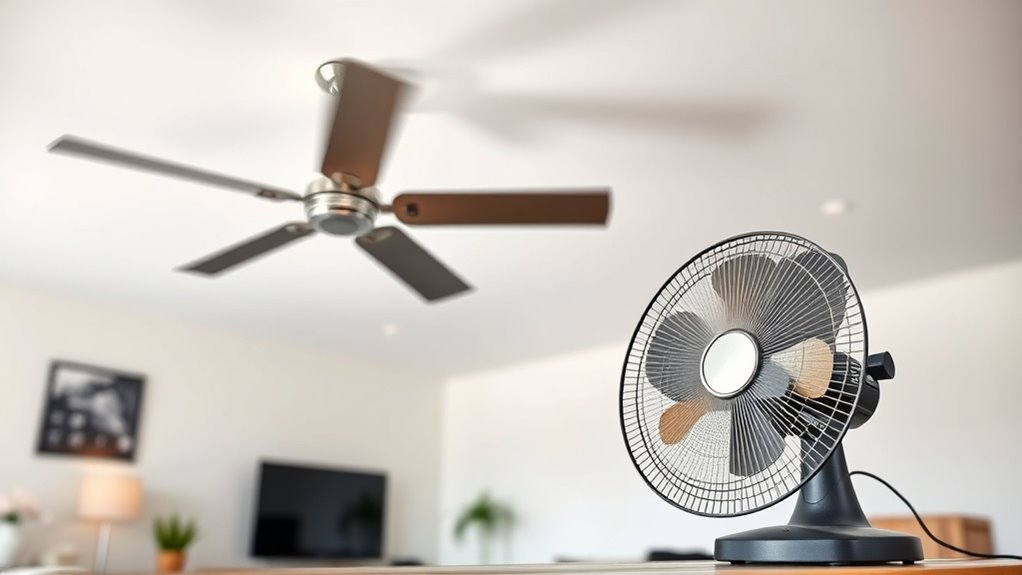
Maintenance requirements and longevity vary considerably between ceiling fans and portable fans. Ceiling fans typically need less frequent maintenance but require occasional dust buildup removal and motor maintenance to keep them running smoothly. Portable fans, on the other hand, often need more regular cleaning and part replacements due to their exposed components.
- Dust buildup can impair efficiency in both fan types, requiring regular cleaning
- Ceiling fans benefit from periodic motor maintenance to prevent noise and failure
- Portable fans may need component replacements more often due to wear and tear
Frequently Asked Questions
Which Fan Type Is Quieter During Operation?
When considering noise levels, portable fans tend to be quieter because they produce less sound insulation noise during operation. Ceiling fans can generate more noise, especially if the motor isn’t well-insulated or if blades wobble. If quiet operation is your priority, a portable fan generally offers a more peaceful experience, while ceiling fans may occasionally produce background noise, but quality models with sound insulation can minimize this issue.
Can Portable Fans Replace Ceiling Fans Permanently?
Imagine you’re in a time machine, thinking portable fans could replace ceiling fans permanently. While portable fans offer great installation convenience, they fall short on energy efficiency and cooling coverage for large spaces. Ceiling fans are better suited for long-term, energy-efficient comfort, especially in bigger rooms. Portable fans work well for temporary relief, but they can’t truly replace ceiling fans for consistent, whole-room cooling.
Do Ceiling Fans Improve Indoor Air Quality?
Ceiling fans do improve indoor air quality by enhancing air circulation, which helps disperse indoor pollutants and reduce stuffiness. They also assist with humidity control, making the environment more comfortable. While they don’t purify the air directly, their continuous airflow can make a room feel fresher and less stagnant. So, if you’re looking to boost air quality, ceiling fans are a good, energy-efficient choice for improving overall indoor comfort.
Are There Safety Concerns With Portable Fans?
Did you know that portable fans are involved in over 1,000 electrical hazard-related injuries annually? Safety concerns with portable fans include potential electrical hazards and ventilation safety issues. You should make sure your fan is properly grounded, kept away from water, and used in well-ventilated areas to prevent accidents. Regularly inspect cords and switches, and avoid overloading outlets to keep your space safe.
How Do Fans Impact Allergy Symptoms?
Fans can influence your allergy symptoms by affecting airborne allergens and ventilation effectiveness. When you use a fan, it can circulate dust, pollen, and pet dander, potentially worsening allergies if filters aren’t maintained properly. However, fans also improve ventilation, helping to reduce indoor allergen buildup. To minimize allergy issues, keep fans clean, use HEPA filters, and guarantee proper ventilation, which can help you breathe easier and reduce allergy symptoms.
Conclusion
Whether you choose a ceiling fan or a portable fan, understanding their strengths helps you cool smarter. Did you know that ceiling fans can save up to 40% on energy costs compared to air conditioning? If you want a long-lasting, energy-efficient solution that improves air circulation and complements your room’s decor, a ceiling fan might be your best bet. Consider your space and needs, and pick the fan that keeps you comfortable without breaking the bank.
